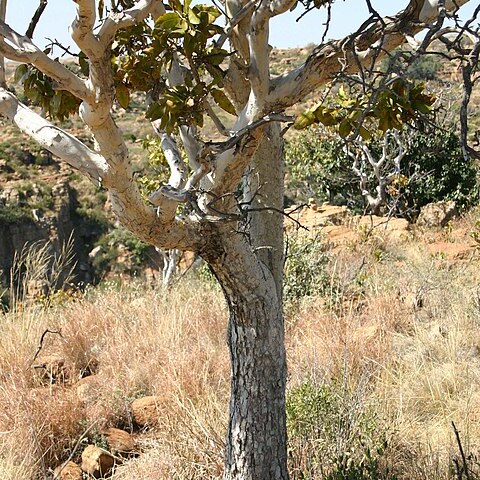A small or medium sized tree. It grows 3-8 m high. It has a spreading crown. The trunk can be 15-20 cm across. The trunk is often white with grey peeling bark. The young branches and shoots are white. The tree loses its leaves during the year. The leaves are simple and alternate. They are 3-10 cm long and 2-5 cm wide. They are wide and sword shaped. They are yellow-green and with easy to see veins. The leaf stalks are short and thick. The flowers are yellow. They have a sweet smell. They occur as many together in arrangements up to 13 cm long. The fruit are usually 3 kidney shaped carpels. Each is 1.4 cm long. They are black when mature.
Leaves petiolate; lamina 3·5–18·5 × 1·3–5·7 cm., elliptic to oblong or oblanceolate (rarely obovate), acute or obtuse to rounded (often apiculate) at the apex, with margin entire or densely appressed-spinulose-serrulate towards the apex, narrowly cuneate or attenuate to rounded (rarely truncate to subcordate) at the base, subcoriaceous, with numerous (c. 20–30) lateral nerves and densely reticulate tertiary venation more prominent above than below; petiole 2–6 (8) mm. long, triangular in section or ± flattened, stout, often ± swollen; stipules oblanceolate or elliptic to subulate, 1–2 cm. long.
Shrub or small tree up to 8 (10·5) m. high, with bark smooth, grey to bluish-grey, flaking in thin sheets to reveal cream to yellow-brown or pale grey patches; branches slender or rather stout, spreading widely, creamy white at first, becoming dark grey.
Shrub or tree, up to 10 m high. Bark flaking to expose patches of a different colour. Flowers in simple, pendulous, clustered, many-flowered racemes. Carpels 6-8, attached centrally on inside of torus; drupelets kidney-shaped. Flowers soft yellow.
Flowers (20) 25-c. 50, in a simple (rarely compound towards the base) terminal erect or pendulous raceme (1·5) 2·5–10·5 (15) cm. long in fruit; pedicels 1·2–2·7 cm. in fruit, articulated at the base or in the lower 1/3.
Sepals 5–9 mm. long in flower, elliptic to obovate, rounded, becoming red or pink, 10–19 mm. long, convex and eventually reflexed in fruit.
Stamens with anthers 1–2 mm. long, about 1/2 as long as the filaments, straight, dehiscing by apical pores.
Petals golden to pale yellow, 9–11 (13) × 4–6·5 mm., obovate to oblanceolate.
Drupelets reniform, inserted centrally, 11–14 × 7–10 mm.: embryo curved.
Carpels 7 (rarely 8), with styles free at the apex.


